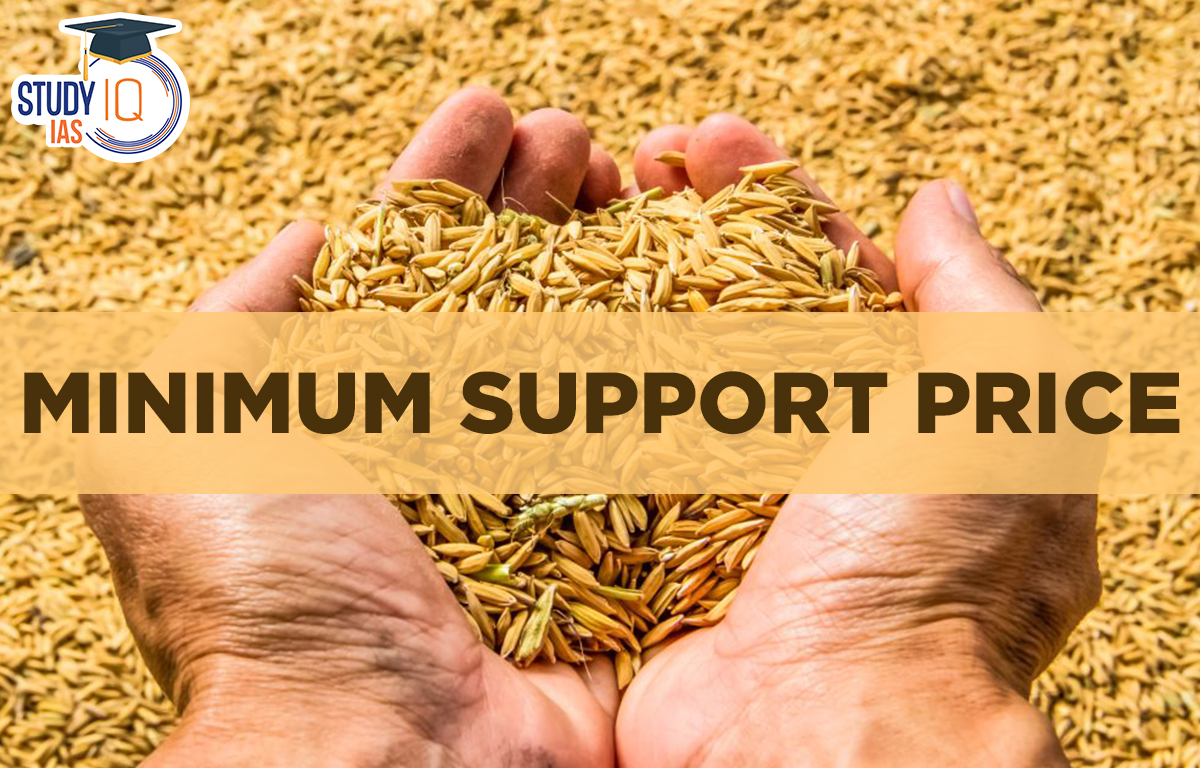Table of Contents
Context: The Union cabinet approved giving rise to MSP of 14 Kharif crops. Farmers demand a radical shift in government budgets to address their crises.
What is Minimum Support Price (MSP)?
- The Minimum Support Price (MSP) is the price at which the government commits to buying farmers’ crops if market prices drop below this predetermined level.
- The Government sets the MSP at the start of the sowing season, based on the recommendation of the Commission for Agricultural Costs and Prices (CACP).
- In case the market price for the commodity falls below the announced minimum price due to bumper production and glut in the market, government agencies purchase the entire quantity offered by the farmers at the announced minimum price.
Minimum Support Price Overview
Key Issues and Demands of Farmers for MSP
- Statutory Minimum Support Price (MSP): Farmers demand an MSP at C2+50% (one-and-a-half times the comprehensive cost of production) as recommended by the M.S. Swaminathan Commission.
- Budgetary provisions are essential to implement this MSP to resolve the agrarian crisis.
- Reducing Input Costs: The cost of production is rising due to expensive fertilizers, seeds, insecticides, diesel, water, and electricity.
- The Budget should reduce these input costs and control corporate pricing to aid public sector companies producing these inputs.
- Loan Waiver: A complete one-time loan waiver for farmers and agricultural workers is crucial to prevent farm suicides.
- The government has previously written off ₹16 lakh crore in corporate loans.
- Addressing loan waivers, production costs, and MSP together can resolve 70% of the agrarian crisis.
- Crop Insurance Scheme: A comprehensive crop insurance scheme, different from the Pradhan Mantri Fasal Bima Yojana (PMFBY), is needed.
- PMFBY is seen as benefiting insurance companies rather than farmers.
- Budgetary provisions should support a new scheme to aid farmers facing climate-related challenges like droughts, floods, unseasonal rains, and hailstorms.
- Irrigation and Power: Public sector investment in irrigation and power has declined over the past decade.
- Privatisation has increased the cost of water and power.
- The Budget should complete pending irrigation projects and address issues in power production to benefit a large section of land and consumers.
- Expansion of MGNREGA: The government has reduced funds for MGNREGA, limiting workdays to 42.
- Increasing wages to ₹600 and workdays to 200 is necessary to support rural employment.
- Land Reforms: The shift from “Land to the Tiller” to “Land to the Corporates” has led to extensive farmland acquisition by corporates.
- Land acquisition should be limited to public purposes only.
- Radical land reforms are required to protect farmers’ interests.
- Wealth and Inheritance Taxes: The government should impose wealth and inheritance taxes to raise resources.
- Corporate tax reductions should be reversed, with higher taxes on the rich and relief for the middle class.
- Increasing direct taxes and reducing indirect taxes is necessary for equitable fiscal policy.
Background of Minimum Support Price
- MSP, or Minimum Support Price, is its full name. India is an agricultural nation, so the government must give our farmers’ security top priority. The Indian government only established MSP for this reason.
- Minimum Support Price was established in 1966–1967 to shield farmers from such concerns. The Indian government sets the minimum support price for 24 commodities twice a year, depending on the bumper production.
- It is nothing more than the price set by the Indian government to protect farmers’ rights if prices drastically decline during a period of peak production. Minimum Support Price is a kind of guarantee price that the farmers would receive regardless of the circumstances surrounding distress sales for them to obtain the necessary food grains.
- The Department of Agriculture and Cooperation under the Government of India is responsible for deciding the Minimum Support Price by the recommendations of the Commission for Agricultural Costs and Prices before the sowing season of the crops, particularly for 22 crops.
Features of MSP
- Safety net: The MSP protects farmers against excessive price falls during years of high production. It also ensures farmers a minimum income for their produce, especially during market fluctuations.
- Guarantee price: The MSP is a guaranteed price for farmers’ produce from the government.
- Pre-announced price: Farmers are paid a pre-announced price for their crops.
- Government intervention: The MSP is a form of government intervention to help farmers prevent losses.
- Final decision: The Cabinet Committee on Economic Affairs (CCEA) of the Union government makes the final decision on MSP levels and other recommendations.
- Supply and demand: Supply-demand dynamics for the crop, both domestically and internationally, play a role in MSP determination.
- Production costs: The costs incurred by farmers during the production process, including variable and fixed costs, impact the MSP calculation.
List of Minimum Support Price Crops
The Commission for Agricultural Costs & Prices (CACP) recommends Minimum Support Prices (MSPs) for a total of 22 crops, categorized into 14 Kharif crops, 6 Rabi crops, and 2 other commercial crops. However, it’s worth noting that for sugarcane, the Fair and Remunerative Price (FRP) is determined by the Department of Food & Public Distribution separately. These 22 crops encompass a variety of staples and cash crops, including:
| List of the MSP Crops | |
| Paddy | Soyabean |
| Bajra | Nigerseed |
| Jowar | Sunflower |
| Maize | Sesamum |
| Arhar | Cotton |
| Ragi | Barley |
| Moong | Wheat |
| Groundnut-in-shell | Gram |
| Urad | Rapeseed/Mustardseed |
| Masur (lentil) | Jute |
| Copra | Safflower |
| Important Facts |
The government fixes MSPs for 22 mandated agricultural crops(Kharif crops (14), Rabi crops (6), and commercial crops (2)) and in addition, the MSPs of toria and de-husked coconut are fixed on the basis of the MSPs of rapeseed/mustard and copra, respectively.
|
Significance of Minimum Support Price
- Income Security for Farmers: MSP provides a safety net for farmers by ensuring they receive a minimum price for their produce, protecting their income from market fluctuations and ensuring financial stability.
- Price Stability: MSP helps stabilize agricultural prices by setting a floor price for certain crops, preventing sharp declines in prices that could lead to distress sales and financial losses for farmers.
- Incentive for Production: MSP acts as an incentive for farmers to increase production of crops covered under the MSP regime, as it provides assurance of a minimum price for their produce, encouraging investment in agriculture.
- Food Security: MSP plays a crucial role in ensuring food security by incentivizing the production of essential food crops and maintaining stable supplies in the market, which is essential for meeting the nutritional needs of the population.
- Rural Economy Support: MSP contributes to the overall development of rural economies by supporting farmer incomes, reducing rural poverty, and stimulating economic activities in agrarian regions.
- Government Intervention: MSP represents government intervention in agricultural markets aimed at protecting the interests of farmers and ensuring the stability of the agricultural sector, which is vital for the overall economy.
Minimum Support Price Determinants
The Commission maintains in mind the numerous Terms of Reference (ToR) granted to CACP in 2009 when suggesting the pricing strategy for various commodities covered by its mandate. As a result, it analyses:
- Supply and demand;
- The price of production;
- Market price movements, both nationally and internationally;
- Parity in inter-crop prices;
- The conditions of commerce between agriculture and other sectors;
- A minimum profit margin of 50% above the cost of manufacturing;
- Potential effects of MSP on users of the product.
Process of Awarding MSP
- Recommendation Stage: The Minimum Support Price (MSP) is determined based on the recommendations of the Commission for Agricultural Costs and Prices (CACP). Each year, the CACP submits its recommendations to the government through Price Policy Reports, taking into account factors such as cost of production, demand and supply, market price trends, and inter-crop price parity.
- Decision Stage: The final decision on MSP levels is made by the Cabinet Committee on Economic Affairs (CCEA), chaired by the Prime Minister of India. This decision is based on the Price Policy Report, the views of state governments, and the overall demand-supply situation in the country.
- Procurement Stage: The Food Corporation of India (FCI), along with State agencies, serves as the nodal agency for procurement at the beginning of the sowing season.
Minimum Support Price Policy
| Various Committees Related to MSP |
|
Issue Associated with Minimum Support Price Policy
1. Limited Scope
Only two commodities—rice and wheat—are purchased despite the official announcement of MSPs for 23 different crops because they are allocated through NFSA (National Food Security Act).
2. Implemented ineffectively
Only 6% of the MSP could be obtained by farmers, according to the Shanta Kumar Committee’s 2015 report. This immediately translates to 94% of farmers in the nation not receiving the MSP’s benefits..
3. Additional Procurement Price
The existing MSP framework is unrelated to domestic market prices. Its main purpose is to satisfy the NFSA’s requirements, therefore rather than being an MSP; it is effectively a procurement price.
4. Makes agriculture dominated by wheat and paddy
Overproduction of rice and wheat due to the skewed MSP system discourages farmers from growing other crops and horticultural products, which have higher demand and may, therefore, boost farmer income.
5. Middlemen-Dependent
Additionally, the MSP-based procurement system is dependent on intermediaries, commission agents, and APMC officials, all of whom are difficult for smaller farmers to contact.


 Growth in Gold Loans and NPAs, Reasons a...
Growth in Gold Loans and NPAs, Reasons a...
 New Phase of Operation Chakra to Combat ...
New Phase of Operation Chakra to Combat ...
 Soyuz Aircraft: History, Design and Sign...
Soyuz Aircraft: History, Design and Sign...





















